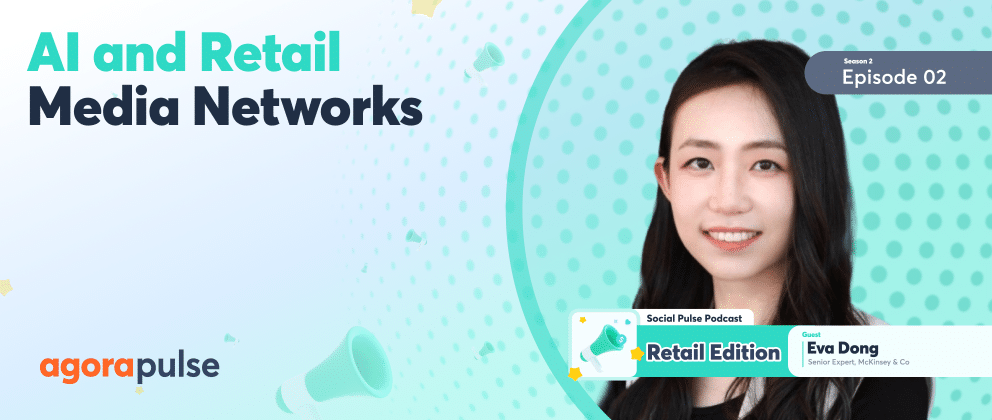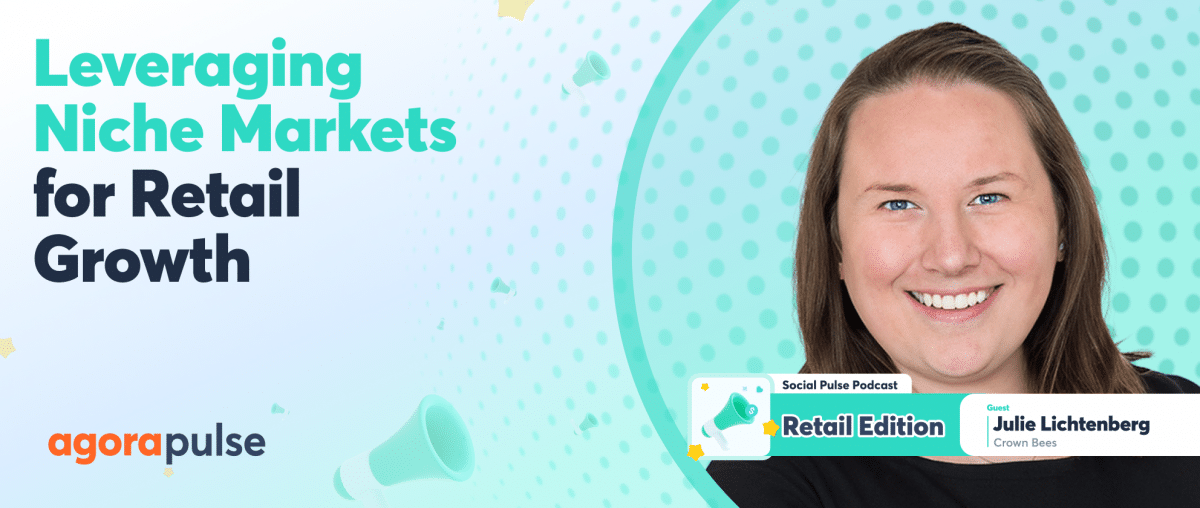Now imagine walking into a store where every promotional sign you see is tailored just for you, recommending exactly what you need based on your past purchases and preferences.
Now picture that level of personalization extending to your online shopping experience.
This isn’t a distant future scenario, but a present-day reality, thanks to the power of generative AI in retail media networks. Major players like Amazon, Microsoft, and Walmart are leading this transformation, showcasing the monumental shifts in enhancing operations and revolutionizing customer experiences.
But what exactly is generative AI, and how is it being applied in retail media networks? Does it hold the power to change the way retailers interact with customers? And, more importantly, how can other brands, including smaller retail media networks, tap into this technology to stay competitive?
Listen to the podcast below to get answers to those pressing questions or read on for the transcript.
Our guest today on Social Pulse Podcast: Retail Edition is Eva Dong, a seasoned expert with a decade of AI and digital marketing experience. Experience. Eva has held transformative leadership positions at McKinsey & Company and Visa and is now an entrepreneur dedicated to bringing AI-driven marketing solutions to brands around the world.
We’re excited to dive into the transformative power of GenAI and retail media networks and how brands can leverage this technology to enhance their customer experiences.
The Start of the AI World
Mike Allton, podcast host and Agorapulse’s chief storyteller: Can you start by just sharing your journey in the world of AI and marketing technology?
Eva Dong: I started my journey in the world of AI and then encountered marketing/marketing technology on my way. Now I’m fully in the cross-domain of AI and marketing technology and making [them] my superpower. So to start with, I was a machine learning data scientist at Visa, and then I joined McKinsey & Company under the marketing sales umbrella.
During that time, I started to serve my clients using machine learning to serve them on marketing topics, such as: how to use machine learning to predict customer behavior, such as their next product to buy, such as their lifetime value, run a lot of customer segmentation for personalization purposes.
And while I [was] serving my clients, I started to realize it’s impossible to fully leverage machine learning and AI without a robust infrastructure of marketing.
So, starting at that time, I started to rebuild and transform my client’s marketing technology infrastructure and analytics capability at the same time. This way turned out to be a very impactful and substantial impact. So, therefore, in the last 10 years, I’ve been in the field of AI and marketing technology, and the field is evolving dramatically and is getting more and more exciting.
Mike Allton: We’ve talked about AI on this show before, and everyone listening has got some level of understanding, but just to level set:
Can you explain what generative AI is and how it may be different from other types of AI?
Eva Dong: I think everybody’s talking about it, but sometimes some people don’t fully understand it and are just riding the wave. Maybe I’ll take a step back and start with the larger concept of AI.
Artificial intelligence is a really large and general concept with a long history. Artificial intelligence refers to the simulation of human intelligence in a machine that is programmed to think and learn like a human. Under the AI umbrella, there are many subsets. So to start with—I mentioned, I started my career as a machine learning data scientist—machine learning is a subset of AI that involves using data to train algorithms to make predictions and decisions.
In the retail world, specifically, for example, machine learning can analyze historical sales data to forecast future sales.
Another concept is called deep learning.
Deep learning is a subset of machine learning. You can think about it as machine learning in neural networks. This way, it gets more complex and deeper and can recognize patterns and make decisions using a neural network.
An example of that is: We’ll be using deep learning to analyze customer feedback, and you can identify the sentiment of that.
A different set of AI is called generative AI. We call it Gen AI. And that part is set up, part of everything I just talked about with this capability to produce original outputs. Generative AI is really a typical of AI that generates new content. It could be text, images, videos, music, anything. So in today’s world, for example, ChatGPT generates text, Dall-E and Midjourney generate images, Sora generates videos.
In the retail world, for example, you can use this kind of tool to generate personalized marketing messages or product images.
In summary, AI has different subsets, but any type of AI is trying to mimic human intelligence.
Mike Allton: Now, you’ve written an article on LinkedIn, AI-driven marketing, transforming retail media networks with Gen AI, and it highlighted some pioneering examples from Amazon, Microsoft, and Walmart. In the article, you mentioned a bunch of use cases about how these large retail media networks were leveraging Gen AI to achieve higher efficiency and effectiveness.
Three of them I found interesting: You had in-store, retail-media-enhancing product listings and descriptions, personalization, and customer engagement.
I’d love to discuss them one by one if you wouldn’t mind starting with in-store retail media.
What exactly have these pioneers done, and what’s been the impact?
Eva Dong: In-store retail media is interesting.
The goal of it is to bridge the digital and the physical advertising. So when something becomes a trend, I find it cool because everything we have been talking about in the last two decades is like, “You got to bring things online. You’ve got to transform from offline to online. You’ve got to transform from physical to digital.”
But it seems like the trend is circling back. We are bringing things from the digital to the physical world. But actually, it makes sense when you think about it.
Online and In Person: Striking the Right Balance
So when we say retail media network, it’s all about real estate, right? You have a space on your website, and you let the brand use that space to advertise for themselves but similarly, brands have stores. Stores also have real estate. You can also leverage that to advertise for themselves for the brands and then charge them a fee for it.
In that sense, Walmart is, obviously, the perfect leading leader in this space—like Walmart, as all the US listeners know, has a lot of stores across all kinds of parts of the United States. So I know Walmart specifically has rolled out this capability in-store retail media to 5,000 of their stores. So to explain it more, I said this part in storytelling media is to bring the bridge of digital and physical advertising. It aims to provide a very immersive and interactive experience for the customers.
For example, in the store, there might be digital screens. And then you can find all kinds of personalized promotions and product recommendations for you. There also could be targeted audio ads in the specific area of the store that you can listen to, or product demos that you can scan a QR code in the store, and then it will open up a website and direct you to do something.
Among them, I think there are two capabilities I find very advanced and new:
- One thing is called interactive display. So these are the digital screens I just talked about in the store. Sometimes, they can recognize who you are maybe through their loyalty program, Walmart Plus, and then they can know who you are, what you have purchased, and even what you have browsed online. So maybe in your customer decision journey, they know you browse this vacuum cleaner online, and you come to the store to check it out. They will know, “Okay, let me display all the vacuums, and technical stuff for you on the screen, and you can play with it. It could be 3D.” This way, the display can respond to customer queries in real time and answer them with real needs.
- Another one similarly answering things in real-time is a virtual assistant. So maybe you can open up a bot to chat with you while you’re in the store. It can help you to find products, it can answer questions for you, and it provides a very personalized experience—but not [by] adding any pressure to the human stuff in the store.
That’s two things I find very interesting.
So for Walmart, specifically, I think Walmart is very big on retail media networks. I think their annual revenue is over 3 billion. An industry estimate is that in-store retail media accounts for about 10 to 15 percent of their total revenue. So that will translate to 300 million dollars, which is very significant. But besides that, there’s more to it.
In-store retail media is growing faster than digital, estimated at about 25 to 30 percent growth rate year after year. Also, there’s already stats coming back (even though it’s early on) that campaigns using the True Omnichannel Retail Campaign have a 20 to 30 percent higher return on spend than the digital-only campaigns.
And lastly, as you can imagine, with the amount of traffic to Walmart stores every day, this kind of in-store retail media can reach a lot of foot traffic that the online world or the app world can’t reach. So overall, that’s a very good win and a big growth driver for Walmart right now.
Mike Allton: That makes a lot of sense.
I know we are very close to having even more immersive experiences. My friend Katie Richman has a startup, Loud Labs. I’ve had her on my other podcast, AI and Marketing Impact. She’s talked about how they’re combining artificial intelligence with augmented reality and that knowledge of the location that geolocation targeting so that as folks are walking up and down these aisles, for instance, their device might send a haptic signal to their wrist. Or if they happen to be wearing a wearable, they might see a pop-up display that provides a lot of that additional contextual information that you’re talking about—without necessarily having to have a screen installed on the shelving unit or something like that, which would be more cost-effective for the retailer.
But I’m wondering, while we were talking about these large retail media networks.
What’s an example of a smaller retail media network? And what can they learn from the things that you’re talking about?
Eva Dong: First of all, if you already have a lot of stores for your brand, you should definitely use it.
I think the definition of an omnichannel has been evolving. So as marketers, we all know omnichannel is the best. A lot of brands start with their physical stores. They move everything to the online store and then talk about omnichannel.
But I think now things start to change a little bit. You have to bring the online experience to your offline experience, too. It’s not that difficult to install some digital displays.
The thing you mentioned is much more interesting, but it seems like much more advanced in the future, but something just like digital displays in your store could be very effective. It can add additional revenue streams for you because, for your clients, you are not only providing them advertising online but also offline providing that true omnichannel experience. And secondly, you can offer advertisers a different way to reach your customers. It could be a touch point along their distant journey. It could be more effective and answer things they couldn’t answer online.
Mike Allton: That makes a lot of sense, folks. We’re talking with Eva Dong about the impact of AI on retail marketing and retail media networks.
Sign up now for a free trial of Agorapulse and get started right away.
Generative AI for Retail Marketing
Mike Allton: So, Eva, what was the second use case that you found about how generative AI is being leveraged for retail marketing?
Eva Dong: The second thing I find very interesting is with Amazon, about enhancing product listing and descriptions using Gen AI.
As we all know, Amazon has a lot of vendors and sellers on it, and there are tons of different SKUs. Amazon provides a lot of tools for this kind of vendor, regardless of how big or small.
- One thing they have been using Gen AI to do is to use Gen AI to enhance their product listings. So this way they can write product descriptions very quickly and efficiently. They can generate human-like texting, making the description very engaging and informative.
- Also, Amazon ensures all the product descriptions can maintain a consistent tone and style across the platform. This is especially very important for Amazon, because they’re just so many vendors and so many products, and sometimes it’s impossible to control everyone. The stats I heard are there are over a hundred thousand Amazon sellers already adopting this kind of AI tool for product descriptions, but I suspect the actual number should be higher than a hundred thousand.
There are many impacts from this technology: efficiency and effectiveness.
- On the efficiency side, I think it’s quite easy to understand. Once you start using AI to write things, it can be very efficient. It can save a lot of time, especially when you have a lot of SKUs. And it’s very good for small businesses too, who don’t have a lot of resources to do this kind of ad copy.
- And then for effectiveness, I’ll break it down to two things: I think the first thing will be improved product discoverability. So once the AI listing writes your product description, it can be more detailed, more accurate, and it can be optimized for the search engines, which means it knows what kind of keywords to use—and it can be more comprehensive. This kind of product listing will make the product rank higher and eventually, that means driving more traffic to your listing and driving more revenue.
The second part will be after you have that discoverability, after traffic already [has] come to your product detail page, a more clear and engaging product description can help customers feel more confident about your product. And eventually, that means a higher conversion rate and higher revenue.
Mike Allton: Long-time listeners of the show, you can go back and listen to our episode with Feedonomics because they’re employing a lot of these same technologies that are helping us take the products that are in our shops and distributing them across many of these retail media networks and other kinds of shops like Facebook shops, Pinterest shops, and so on. [They’re] allowing us to effectively, on the fly customize a lot of those descriptions and product titles and that sort of thing for each platform because it is a little bit different for each platform—as well as for each different audience. So that’s really fascinating that we’re integrating a lot of these tools.
What’s been the impact or strategy when it comes to these smaller retail networks?
Eva Dong: I think you have to help each other.
When Amazon helps the sellers and vendors to write better product descriptions and get more traffic and more revenue, eventually it will make the sellers and vendors more confident and put more resources into that Amazon channel compared to other channels. Eventually, it becomes beneficiary ecosystems better for each other.
So I think for smaller networks, you also can think about, “What is the roadblock for your merchant, vendors, and sellers? Are they struggling with product listing? Are they wasting a lot of time to write this kind of thing but couldn’t get a ranking that they deserve?”
If that’s the case, I think it couldn’t make sense to implement AI tools like this to generate more clear, concise, and very attractive product descriptions for themselves to make themselves easier. And they will like your channel more, and eventually, that’s more revenue for the retail media network.
Mike Allton: What was the third use case and what’s the impact that it’s had?
Eva Dong: Personalization and customer engagement.
The pioneer I chose is Microsoft. Microsoft is a little bit special compared to Walmart and Amazon. We all know Walmart and Amazon are huge e-commerce who have huge retail media networks, but Microsoft also has a retail media network.
At the same time, Microsoft is also a pure technology company that provides a lot of the tools. So Microsoft is not only a competitor but also an enabler in this game.
And then here I want to talk about personalization and customer engagement. Both of them are not new concepts.
I think for us as marketers and retail experts, we have been talking about this concept for a long time.
“I think the change now is AI makes things so much better, so much deeper. And with all the tools we have, you can just do what you wanted to do 10 years ago much more effectively.
So, for example, personalization, a lot of times we started with customer segmentation, and then we do micro-segmentation, but right now it’s a cookie-level personalization. Like, the personalization is so granular. To each customer coming to my website, what can we do for them?”
Microsoft specifically has a tool called Azure Personalizer, which is a machine-learning-based API that can personalize content for users in real-time. So when they come to your website, you can decide to show them how to sort your product differently and what to recommend to them and all of that will eventually increase engagement and conversions.
Another thing we can talk about is enhanced customer interactions.
ChatBot is not new, but ChatBot is becoming better and better. And then Microsoft provides a suite of all kinds of bots for you.
There could be a customer service bot for your other post-transaction services. There also could be a conversion bot that focuses more on how to attract you and how to give you the best advice to help you on this journey to decide which product to buy. And then lastly, there’s also a lot of vision.
For example: You see someone has a really beautiful dress, but you’re too scared to ask them where they bought it from. So you can take a picture of that dress and then upload it to your search. And then Azure provides this kind of vision API to recognize that it’s not the same product on your website. So all of that has shown very significant impact. The stats I’ve heard are for click-through rates with AI-driven optimization. It can increase by 20 to 30% for conversion rate, it can increase by 15 to 25%. And then, eventually, that translates to revenue growth. I heard specifically for RMN that if you use Azure AI optimization, you can get a 10% increase in growth on average.
All of that is very, very significant if you think about today’s work. Every growth is still valuable.
Mike Allton: Oh, 10 percent is huge. When I’m talking to clients, they’re excited because they’re saying one, maybe two, three percent improvement due to a little bit of a tweak. Conversion optimization of 10 percent is massive.
How are you applying this or recommending that you apply this to smaller retail networks?
Eva Dong: I definitely recommend smaller retail networks to harness AI, like bringing the AI capabilities you can bring to your network. Maybe you couldn’t bring everything. I know Microsoft offers a lot of things, and there are many, many other vendors in the world to offer many, many things.
Think about what is the most needed for you, but the eventual thing is it comes down to 1. you have to personalize the experience for your visitors, and 2. that has to be effective for your merchant.
Challenges of Generative AI
Mike Allton: I’d love for you to talk about some of the challenges and pitfalls that brands might face when they’re trying to integrate generative AI into these kinds of operations.
Eva Dong: I think there are two obvious ones: quantity/quality and data management.
As we all know, all kinds of AI—generative AI specifically—all the large language models heavily rely on data sets.
Quality/quantity. This kind of data set not only needs to be large but also needs to be high quality.
If the data is poor quality, or there’s not enough data, any kind of AI will have inaccurate outputs, or it will start hallucinating. Like, it doesn’t give you the things that you want to do. I think for a smaller retail media network, you couldn’t have like all the data like Microsoft or Amazon. But at the same time, you can still invest in very robust data management practices. You have to make sure your data is very clean, very organized, and up-to-date—and all of that will help you improve the AI tools you already have and then give you better output.
The second part is: There are a lot of tools on the market that you don’t have to start from scratch. You don’t have to build your large language models. A lot of times you can bring a vendor—but I will always suggest you do some kind of tweaking on top of it. Don’t just take things as it is. One thing you can do is RAC (Retrieval Augmented Generation) or if you have more data science capability, do something like fine-tuning, which can add more of your brand tone and brand style to it. That is one part of the data.
Legal/ethical implications. The second part (which is also a very popular thing in the AI world) is ethical and legal considerations. So with the rise of AI, there’s a lot of [questioning] “What are the interactional property rights? Like, can you train on this data? How do you provide data privacy in this new world?” I think, specifically for smaller vendors, not only do you have to take care of your own data privacy and IP rights, but you also have to think about when you bring in an external vendor, “Are they compliant with all kinds of laws?”
This is kind of difficult because a lot of the AI laws are not very comprehensive. The United States just started rolling all these kinds of laws, but none of them are exactly there. Everything is evolving. So we have to stay very informed about the relevant laws and regulations. Once everything changes, you have to pay attention—not only to yourself but also to the third-party vendors you bring in.
Mike Allton: Thank you so much for bringing up the point about data, first from the concept of the data that we’re giving to the AI. It’s got to be cleaned up because garbage in, garbage out.
If we’re giving the AI a bunch of confusing, unclear or incomplete data, it’s not going to give us the kinds of conclusions we’re looking for.
But the other really important point is to be aware of the bias that can work itself into the AI, and retail is a great example. If you’ve had a certain segment of customers who’ve previously purchased a product, the AI isn’t going to understand that there may be other external factors as to why that is. It’s just going to assume that those are the only segment of customers who could potentially be. So, if you’re interested in that particular product, that might not actually be true.
And so those are the kinds of things where it’s so important that humans are looking at the data that we’re inputting into these systems. The output that’s coming out and judging whether or not it’s factual, it’s true, it’s not hallucinatory, and there’s no bias inherent in those conclusions.
So, thank you so much for sharing that. Eva, you’ve been absolutely amazing. This has been such a thought-provoking episode.
For folks who want to learn more from you, where can they go to connect with you?
Eva Dong: I’m very active on LinkedIn. You can find me just by searching “Evadong” or “Evadong 1010” on LinkedIn.
And then I also run a newsletter called Smart AI Marketing on LinkedIn. Some of the points we talked about today (including the article Mike mentioned about Retail Media Networks and Gen AI) are also some of the articles in my newsletter. So feel free to come to LinkedIn and find me and exchange ideas with me, subscribe to my newsletter.
At the same time, I start to like to do more engagement on Twitter (or X) and also EvaDong1010 on the platform. Looking forward to having more idea-exchanges with professionals and experts in the industry.
Mike Allton: Fantastic. Thank you, Eva. Thank you, all of you, for listening. We will have all those links and more in the show notes.
And don’t forget to find us on Apple, the Social Pulse Podcast: Retail Edition, and drop us a review. We’d love to know what you think. Until next time.






